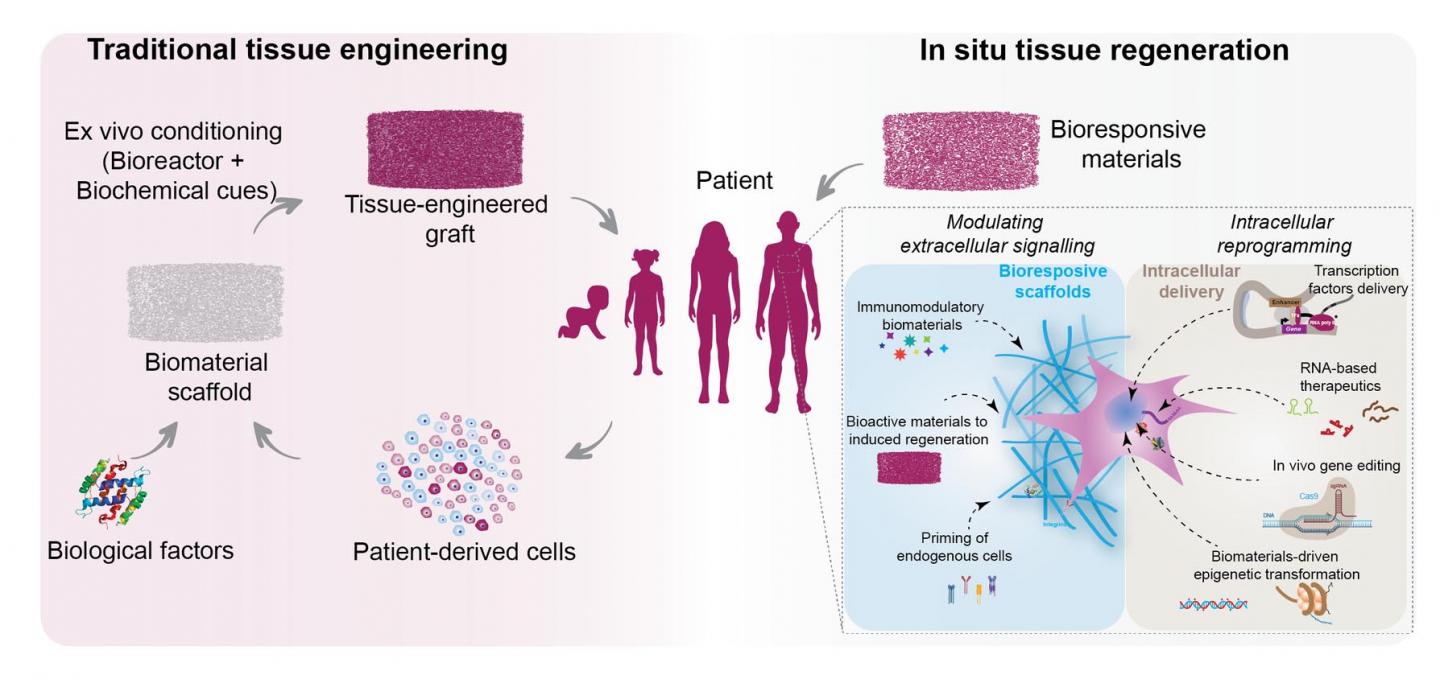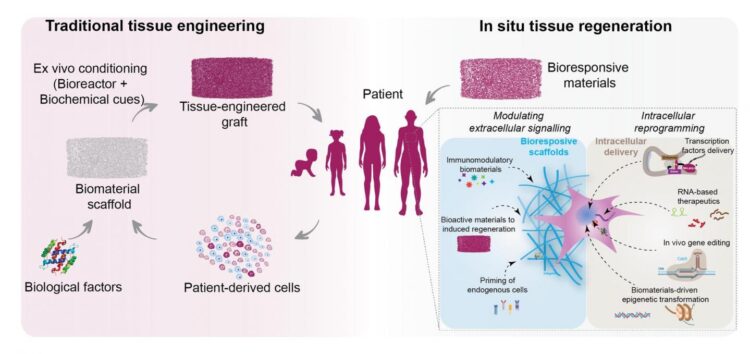Materials to enhance the body’s own regenerative capabilities

Credit: Akhilesh K. Gaharwar
(LOS ANGELES) – Successful tissue regeneration can have major benefits in healing injuries or replacing portions of diseased or damaged tissue in bone, skin, the nervous system and in organs such as the muscle, kidney, liver, lung and heart. But the effectiveness of the body’s own system for repairing such damage can vary greatly, depending on the kind of tissue involved and its location. Tissue engineers have been working to address these limitations by creating substances called biomaterials, which can be used in various ways to boost the body’s ability to heal. In a recent publication in Nature Reviews Materials, Ali Khademhosseini, Ph.D., Director and CEO of the Terasaki Institute, and colleagues discuss the use of biomaterials for tissue regeneration.
When using biomaterials, there are two broad approaches that are commonly used. In the first and more traditional approach, biomaterials are mixed with appropriate cells and biomolecules outside of the body and implanted afterward into the injured area. The implanted construct is then allowed to develop into tissue that will function and regenerate as a replacement for the damaged tissue. In the second approach, specially-designed biomaterials are created without the addition of cells before implantation into the body. The implanted materials are designed to stimulate and enhance the body’s own cellular and chemical healing mechanisms to produce regenerated tissue.
Both approaches can be effective, but there are distinct advantages to the second approach; this has spurred a recent trend towards its usage. Since the procedure does not involve the use of living cells in formulating the biomaterials, its implantation into the body is not subject to as many regulatory barriers. There are also more biomaterials systems available for clinical use with such an approach, and this lends itself towards designing a variety of biomaterials to promote and regulate the many events that are part of the body’s natural healing process.
When an injury occurs to the body, there are three stages of events which occur: inflammation, new tissue formation and tissue remodeling. In the inflammation stage, a variety of immune cells move to the site of injury, removing dead cells and signs of infection and sending out signals for the recruitment of additional cells needed to replace the damaged ones. In the second stage, the recruited cells begin to reproduce and form a cellular matrix at the site, supported by a network of blood vessels. In the third stage, the matrix is reorganized and re-synthesized, to create new tissue.
Researchers can design biomaterials which affect events at any of these stages. One method of accomplishing this is by varying the physical and chemical characteristics of the biomaterials. These factors greatly influence cellular function, migration and proliferation. Physical characteristics such as stiffness, pore size and distribution, surface texture and degradation rate of the biomaterials can be manipulated to facilitate the recruitment of the body’s own restorative cells to the injury site. The chemical properties of the biomaterials can also be manipulated to present biomolecules which will stimulate the recruited cells to grow and reproduce.
Another important influence of biomaterials is in its use of “reprogramming” the body’s regenerative cells at the genetic level. Biomaterials can be created that will deliver factors that will control the gene expression needed to change cells from one type to another. Other factors may be delivered which will result in the production of proteins needed in tissue repair. Still other factors may be delivered by biomaterials via nanoparticles carrying gene-editing tools. These tools can perform precise genetic editing within the cells involved in the healing process.
Advancements made in biomaterial manufacturing, such as in 3D printing, and the diversification of its biomaterials, or bio-inks, have increased the ability to more precisely create complex or custom constructs for implantation. Many more advances in this area are likely to occur in the near future.
Recent progress made in the development of biomaterials has increased its potential for use in augmenting the body’s natural abilities. Future methods in characterizing biomaterials’ performance, such as artificial intelligence platforms and “omics” techniques, can provide further insight at the molecular level. Moving in this direction can lead to an increased success in developing the next generation of bio-responsive materials.
“Leveraging the regenerative potential of the human body via engineered biomaterials is a simple and effective approach to replace injured or diseased tissues. Thus, the development of next-generation of bio-responsive materials to regulate behavior of endogenous cells is expected to play a key role for in situ tissue regeneration,” said Akhilesh K. Gaharwar, Ph.D., first author of the study and Associate Professor of the Department of Biomedical Engineering at Texas A&M University.
“It is anticipated that as we learn more about the biological mechanisms regulating the body, it will enable the development of even better biomaterials for tissue regeneration,” said Khademhosseini, “This research area is an essential component of multiple thrusts within the Terasaki Institute and is likely to change the future of medicine.”
###
Additional author on the review article: Irtisha Singh, Ph.D. Financial support came from the National Institute of Health under grants DP2EB026265 to A.K.G. and HL140951, EB021857, AR073135, AR066193, HL140618 to A.K. and the National Science Foundation CBET 1705852 to A.K.G.
PRESS CONTACT
Stewart Han, [email protected], +1 818-836-4393
Terasaki Institute for Biomedical Innovation
The Terasaki Institute for Biomedical Innovation (terasaki.org) is a non-profit research organization that invents and fosters practical solutions that restore or enhance the health of individuals. Research at the Terasaki Institute leverages scientific advancements that enable an understanding of what makes each person unique, from the macroscale of human tissues down to the microscale of genes, to create technological solutions for some of the most pressing medical problems of our time. We use innovative technology platforms to study human disease on the level of individual patients by incorporating advanced computational and tissue-engineering methods. Findings yielded by these studies are translated by our research teams into tailored diagnostic and therapeutic approaches encompassing personalized materials, cells and implants with unique potential and broad applicability to a variety of diseases, disorders and injuries.
The Institute is made possible through an endowment from the late Dr. Paul I. Terasaki, a pioneer in the field of organ transplant technology.
Media Contact
Stewart Han
[email protected]
Original Source
https:/
Related Journal Article
http://dx.





